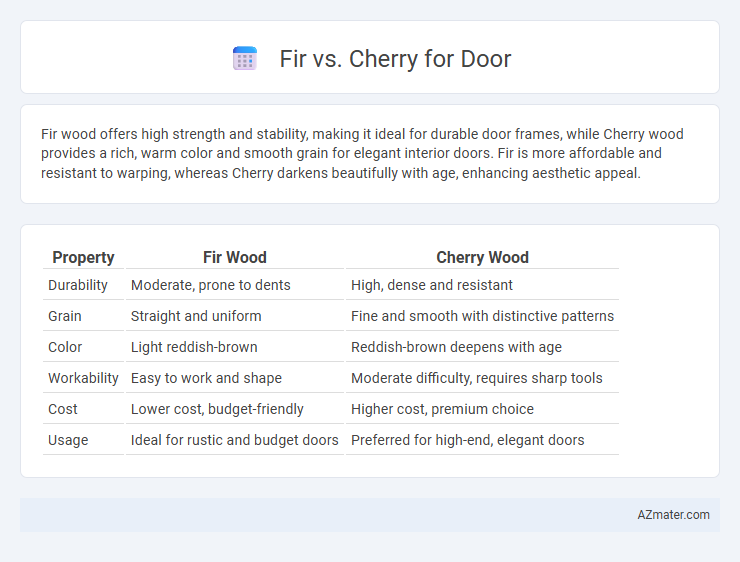Fir wood offers high strength and stability, making it ideal for durable door frames, while Cherry wood provides a rich, warm color and smooth grain for elegant interior doors. Fir is more affordable and resistant to warping, whereas Cherry darkens beautifully with age, enhancing aesthetic appeal.
Table of Comparison
| Property | Fir Wood | Cherry Wood |
|---|---|---|
| Durability | Moderate, prone to dents | High, dense and resistant |
| Grain | Straight and uniform | Fine and smooth with distinctive patterns |
| Color | Light reddish-brown | Reddish-brown deepens with age |
| Workability | Easy to work and shape | Moderate difficulty, requires sharp tools |
| Cost | Lower cost, budget-friendly | Higher cost, premium choice |
| Usage | Ideal for rustic and budget doors | Preferred for high-end, elegant doors |
Introduction to Fir and Cherry Wood for Doors
Fir wood, known for its straight grain and strength, offers durability and a smooth finish ideal for door construction. Cherry wood features a rich reddish-brown color that deepens with age, providing an elegant and warm aesthetic for interior doors. Both Fir and Cherry present distinct advantages: Fir excels in structural stability and affordability, while Cherry is prized for its luxurious appearance and fine texture.
Fir Wood Characteristics and Aesthetic
Fir wood is prized for its strength and durability, making it an excellent choice for doors that require long-lasting structural integrity. Its straight grain and fine texture offer a smooth surface that can be easily stained or painted, enhancing the door's aesthetic appeal. The light reddish-brown hue of Fir provides a warm, natural look that contrasts with the richer, deeper tones of Cherry wood.
Cherry Wood Characteristics and Appearance
Cherry wood features a rich, reddish-brown hue that deepens with age, offering a warm and elegant appearance ideal for door construction. Its fine, straight grain and smooth texture provide a sophisticated aesthetic and excellent workability. Known for its durability and resistance to warping, cherry wood doors maintain their structural integrity while enhancing interior design with a luxurious finish.
Durability: Fir vs Cherry for Door Construction
Fir wood offers moderate durability for door construction due to its straight grain and resistance to warping, making it suitable for interior doors with less exposure to moisture. Cherry wood exhibits higher durability with natural resistance to decay and a dense, tight grain, ideal for doors requiring long-lasting strength and aesthetic appeal. When comparing durability, cherry outperforms fir, especially in high-traffic or exterior applications where longevity is crucial.
Cost Comparison: Fir vs Cherry Doors
Fir doors typically cost significantly less than cherry doors, with fir priced around $150 to $300 per door, whereas cherry can range from $400 to $700 or more due to its premium hardwood quality. The durability and fine grain of cherry wood justify its higher cost, offering a more luxurious and long-lasting door option compared to the softer, more affordable fir. Choosing fir supports budget-friendly projects, while cherry doors enhance the aesthetic and resale value through their rich color and elegance.
Workability and Installation
Fir wood offers excellent workability due to its straight grain and uniform texture, making it easy to cut, shape, and sand for door construction. Cherry wood, while slightly harder, provides good workability with fine finishing properties, but may require sharper tools and more attention during installation. Both woods are popular choices for doors, but fir's lighter weight and smooth machining make installation quicker and more efficient.
Maintenance Requirements for Fir and Cherry Doors
Fir doors demand regular sealing and occasional sanding to prevent moisture damage and warping, making maintenance moderately intensive. Cherry doors require periodic polishing to preserve their rich color and resist surface scratches, benefiting from natural durability that reduces frequent treatments. Both wood types need protection from prolonged exposure to direct sunlight to maintain their structural integrity and aesthetic appeal.
Environmental Impact and Sustainability
Fir wood offers a lower environmental impact due to its rapid growth rate and regional availability, resulting in less deforestation pressure compared to cherry. Cherry wood, while prized for its durability and rich color, grows more slowly and is often sourced from hardwood forests with longer regeneration times, which can contribute to greater ecological strain. Sustainable door manufacturing favors fir when prioritizing renewable resources and minimal carbon footprint.
Best Uses: When to Choose Fir or Cherry
Fir is ideal for exterior doors due to its strength, weather resistance, and ability to take paint well, making it perfect for durable, painted entryways. Cherry is best chosen for interior doors where rich color, smooth grain, and luxurious appearance are desired, particularly in high-end residential or office settings. Selecting fir suits budget-conscious projects requiring sturdy, weather-resistant doors, while cherry enhances spaces needing elegance and warmth.
Conclusion: Selecting the Right Wood for Your Door
Fir offers exceptional strength and durability with a straight grain, making it ideal for sturdy, long-lasting doors, while cherry wood provides a rich, elegant appearance and smooth texture that enhances aesthetic appeal. Choosing fir is practical for exterior doors exposed to harsh weather, whereas cherry suits interior doors where warmth and sophistication are desired. Ultimately, selecting the right wood depends on the door's location and desired properties: fir for robustness and resistance, cherry for beauty and refined finishes.

Infographic: Fir vs Cherry for Door
 azmater.com
azmater.com